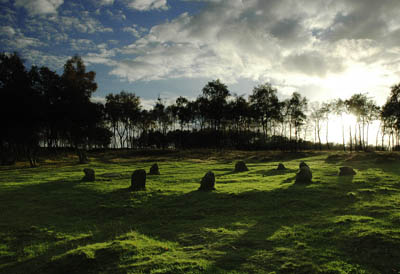
Nine Ladies stone circle. Photo © Peak District National Park Authority
Protestors who have been camping at a threatened popular walking site say they will abandon their camp with the news that permission for quarrying has been withdrawn.
The site at Stanton Moor in the Peak District has a Bronze Age stone circle and is on open access land. Quarry firm Stancliffe Stone has given up its rights to extract stone from Lees Cross and Endcliffe quarries, just to the East of the site.
The Department for Communities and Local Government has confirmed the revocation of permission to quarry the sites. The official decision is the culmination of a long campaign by the Peak District National Park Authority, local pressure groups and protestors worried at the effect of quarrying on the scheduled national monument of Nine Ladies Stone Circle and the area around it on Stanton Moor.
However, as compensation for giving up mineral rights, granted in 1952, the quarry company, owned by Marshalls PLC, has been given permission to expand its Dale View site, which the authority says is in a less sensitive area.
Stanton Moor, near Birchover on the eastern edge of the Peak District, also has important wildlife, including numerous badger setts.
Both the Friends of the Peak District and the Campaign for National Parks have supported the authority’s protracted legal battle to protect the site. The Friends say there are still concerns that Stanton Moor Quarry could be reopened. This quarry actually lies within the open access land.
Peak authority planning committee chair Hilda Gaddum said: “This is the final piece in the jigsaw for Lees Cross and Endcliffe quarries. It brings to an end years of uncertainty for local communities and the company concerned.
“We are grateful for the community’s support and patience, and for the co-operation of the company and landowners in reaching this agreement. We believe it is the best solution that could have been achieved for the environment, residents and all concerned.”
See also
Peak agreement saves Bronze Age site